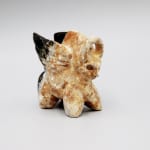Human-Headed Quadruped, Second Millennium BC
Chalcedony
6.8 x 3.5 x 6.2 cm
2 5/8 x 1 3/8 x 2 1/2 in
2 5/8 x 1 3/8 x 2 1/2 in
CC.32
Further images
-
(View a larger image of thumbnail 1
)

-
(View a larger image of thumbnail 2
)

-
(View a larger image of thumbnail 3
)

-
(View a larger image of thumbnail 4
)

-
(View a larger image of thumbnail 5
)

-
(View a larger image of thumbnail 6
)

-
(View a larger image of thumbnail 7
)

-
(View a larger image of thumbnail 8
)

-
(View a larger image of thumbnail 9
)

-
(View a larger image of thumbnail 10
)

-
(View a larger image of thumbnail 11
)

Sumerian art reached its full expression under the Gudea period, when it is characterised by the simplicity of its forms, and by a sober, even severe, style. It is to...
Sumerian art reached its full expression under the Gudea period, when it is characterised by the simplicity of its forms, and by a sober, even severe, style. It is to after this period that this small representation of a mythical creature can be placed. The creature has a human face, with wide drilled eyes which possibly originally held an inlay, a long straight nose, heavy eyebrows that meet in the middle, and an archaic smile. The figure wears some kind of headdress, that takes the form of a loop rising up from behind the ears. The body of the creature is short and squat, with angled forelegs. The hind legs are straight, descending from plump haunches. The creature has a tail which ends in a bushy switch, and a large hump on its back, between a large pair of wings.
The creature’s body shares many features with a bull, and so it can be suggested that this is an early representation of Lamassu, the winged human-bull hybrid known from later Assyrian art. Human-headed winged quadrupeds are known from the Ebla and other areas in the Second Millennium BC, while the goddess Lamassu (despite the masculine representation in later art) is known from the Sumerian period. This piece contrasts with the colossal representations of Lamassu from later times, both in scale and in form.
This piece was likely created as a personal amulet or as a small votive offering. It is a charming glimpse into the personal religion of the Sumerian and Akkadian periods, full of the personality of the artist. While wear and slight damage to the face have left it crude in appearance, the artistry is evident in the tiny details of the tail and the fletching of the wing, especially given the hardness of the stone. The artist has made a clear choice to use the colouration of the stone to his advantage, with the black vein adding drama and emphasis to the wings.
The creature’s body shares many features with a bull, and so it can be suggested that this is an early representation of Lamassu, the winged human-bull hybrid known from later Assyrian art. Human-headed winged quadrupeds are known from the Ebla and other areas in the Second Millennium BC, while the goddess Lamassu (despite the masculine representation in later art) is known from the Sumerian period. This piece contrasts with the colossal representations of Lamassu from later times, both in scale and in form.
This piece was likely created as a personal amulet or as a small votive offering. It is a charming glimpse into the personal religion of the Sumerian and Akkadian periods, full of the personality of the artist. While wear and slight damage to the face have left it crude in appearance, the artistry is evident in the tiny details of the tail and the fletching of the wing, especially given the hardness of the stone. The artist has made a clear choice to use the colouration of the stone to his advantage, with the black vein adding drama and emphasis to the wings.










